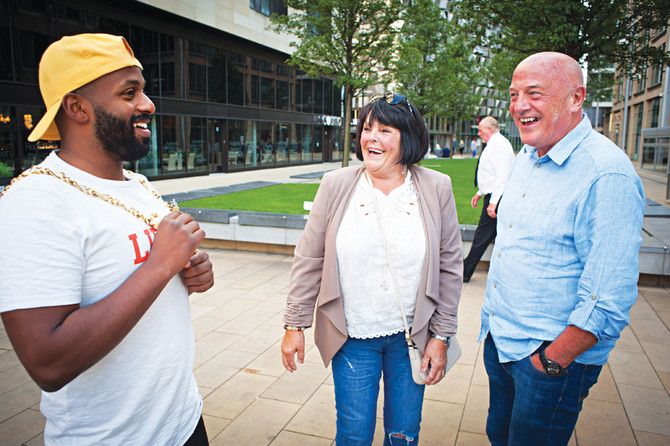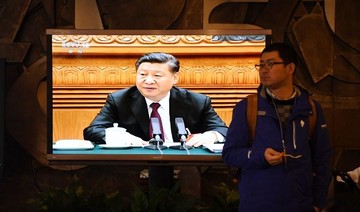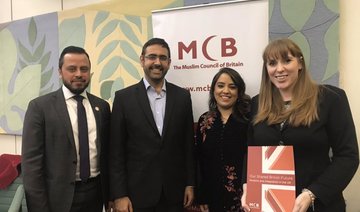CAUX, Switzerland: Magid Magid tore up the rule book when he was elected lord mayor of Sheffield, the no-nonsense former steel town in Britain’s heartland.
As the first Muslim, the youngest person and the first Green Party councillor to take the role, Magid’s appointment divided public opinion in the UK.
But in the three months since the May election, his refreshingly open attitude, relaxed attire and unconventional pronouncements have turned the former refugee from war-torn Somalia into a national treasure — and a global viral sensation.
Now the British-Somali activist has spoken of his aim to make politics more accessible and engage with the younger generation, vowing to continue his “tongue-in-cheek, with a serious undertone” approach to his lord mayoral role.
In an interview with Arab News, he outlined the main goals he wants to achieve during his term of office. “The main two things for me are young people and the creative sector; those are my two passions,” he said. “That is to empower young people and give them the skills and resources to really make change.”
This, he said, includes making politics more accessible in order to encourage young UK citizens into local and national governmental roles.
“My other goal is about championing arts and the creative sector,” he said. “If I can play a role in some of that, it will be amazing.”
The Green Party councillor attracted global media attention minutes into his new role when he posed for his official portrait to mark the appointment — a tradition dating back to the 19th century — by squatting on the plinth of the town hall stairs wearing his official gold livery collar, coupled with chunky Dr. Martens boots.
When Arab News met Magid during a conference in Switzerland — an invitation-only global network for leaders of Muslim backgrounds — he was wearing jeans, an open Hawaiian-style shirt, a baseball cap turned back to front and his trademark wide smile.
“I guess I didn’t get the note about the dress code,” he said, laughing.

Magid Magid at the age of 5
When asked why his appointment — and that photograph — grabbed world media attention, Magid said it is because he had managed to turn “what was a traditionally ‘fuddy-duddy’ role into something that was engaging and accessible.
“It was about doing politics in a different way,” he said. “People want stuff they can relate to and, for me, it was just about being creative and fun, a bit tongue-in-cheek but with a serious undertone.
“I was just being myself. And that was resonating with people much more than if I had listened to the council and those people who were saying: ‘Magid, you are breaking tradition, who do you think you are?’
“But I had expected that before I came to the role. I said to myself: ‘Magid, you have thick skin, but you are going to annoy a lot
of people.’
“I didn’t come with that purpose — but to do what I think is right and stay honest to myself, and then the response was crazy. At times it has been positively overwhelming but it has been great.”
Magid’s story has been well documented. Born in Somalia, he, his mother, four older sisters and an older brother fled the war-torn country when he was 5, spending six months in an Ethiopian refugee camp before arriving in the
UK in 1994, where they were given asylum.
Life at first was a struggle. He had to grow up fast to support his mother, who worked as a cleaner but struggled to learn English and adapt to their new life. That meant Magid taking on roles that were well ahead of others his age.
“I had to do stuff like translate, filling out forms, but it was just part of the learning curve,” said Magid.
While studying at university, Magid founded a mixed martial arts club and was elected to the students’ union sports executive. It was his first foray into championing the voice of others.
Why politics? “I was tired of moaning,” he said. “If you don’t do politics, politics will do you. The people who make decisions for us do not reflect the people they are representing. So it was a case of let me add my voice and speak for the people who are not being represented.
“I just wanted to have a positive contribution to those around me, even if it meant in my small part of Sheffield as a councillor. It was just that notion that I wanted the world to be a better place by having me in it,” he said.
In the three months since taking office, Magid continues to approach his role in a largely unorthodox manner, including inviting letter-writers who condemned his election in the local press to a round-table meeting to discuss issues “head-on.”
“We are in an age of politics where people want something to believe in,” he said. “They choose people now based on emotions, and if you can engage with those emotions, you are on to a winner.”
That, he believes, is another reason he ultimately won people over, including many who were openly hostile to him initially.
“There are not many diverse people … in politics,” he said. “Also, we live in a time that is filled with so much hatred and divide, and when people feel a bit of hope, they want to hold on to that.”
What next for Magid? “Well, no one joins the Green Party to have a career in politics,” he said with a cheeky wink. “For me, I am not sure. I will also take a new opportunity, take myself out of my comfort zone. As long as I have a positive contribution to those around me, then I will be happy.
“I don’t feel like I am here to change the world, but if I can provide a spark in something or somebody — and that person ends up changing the world — then I feel that is my goal.”
























